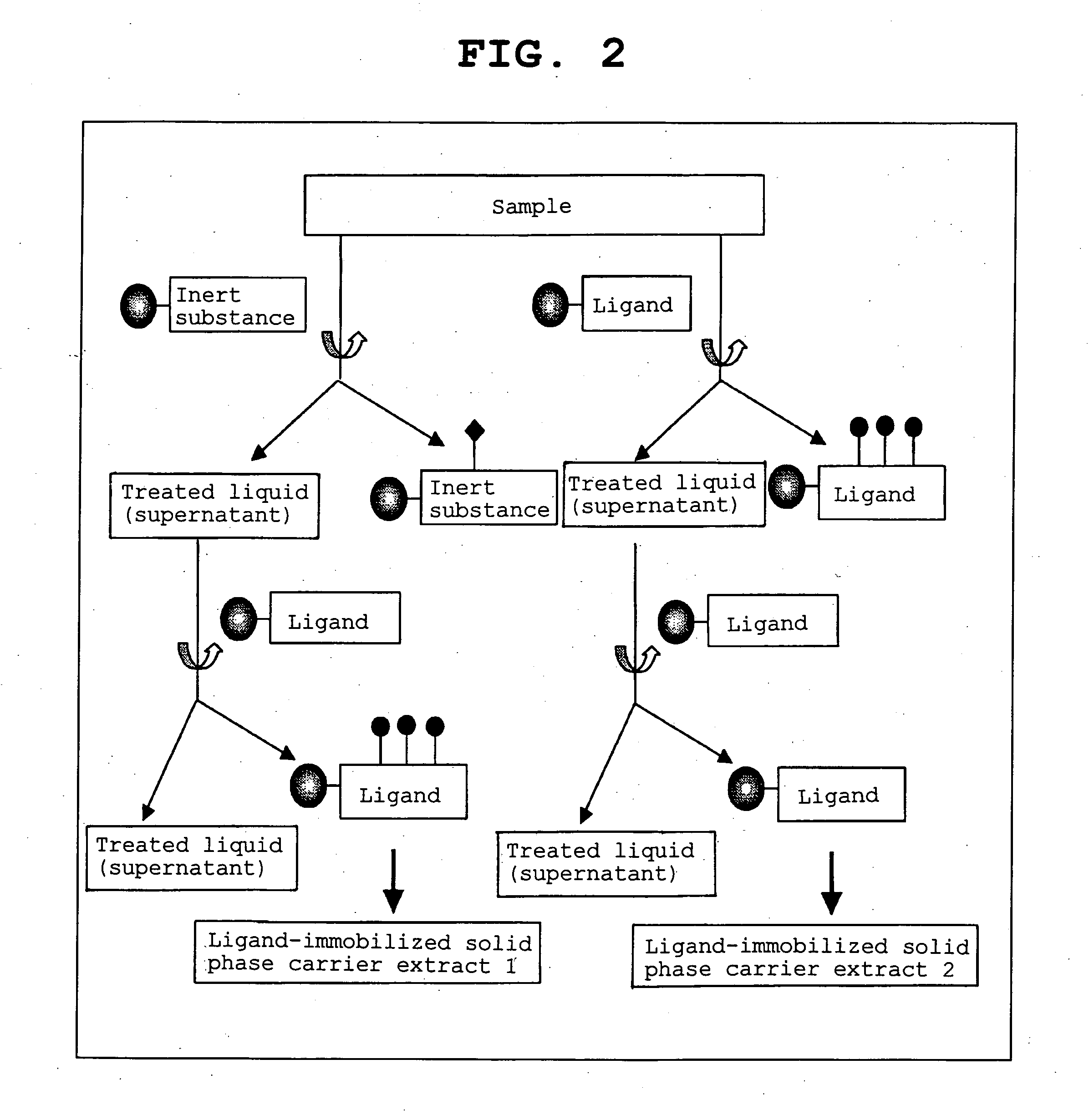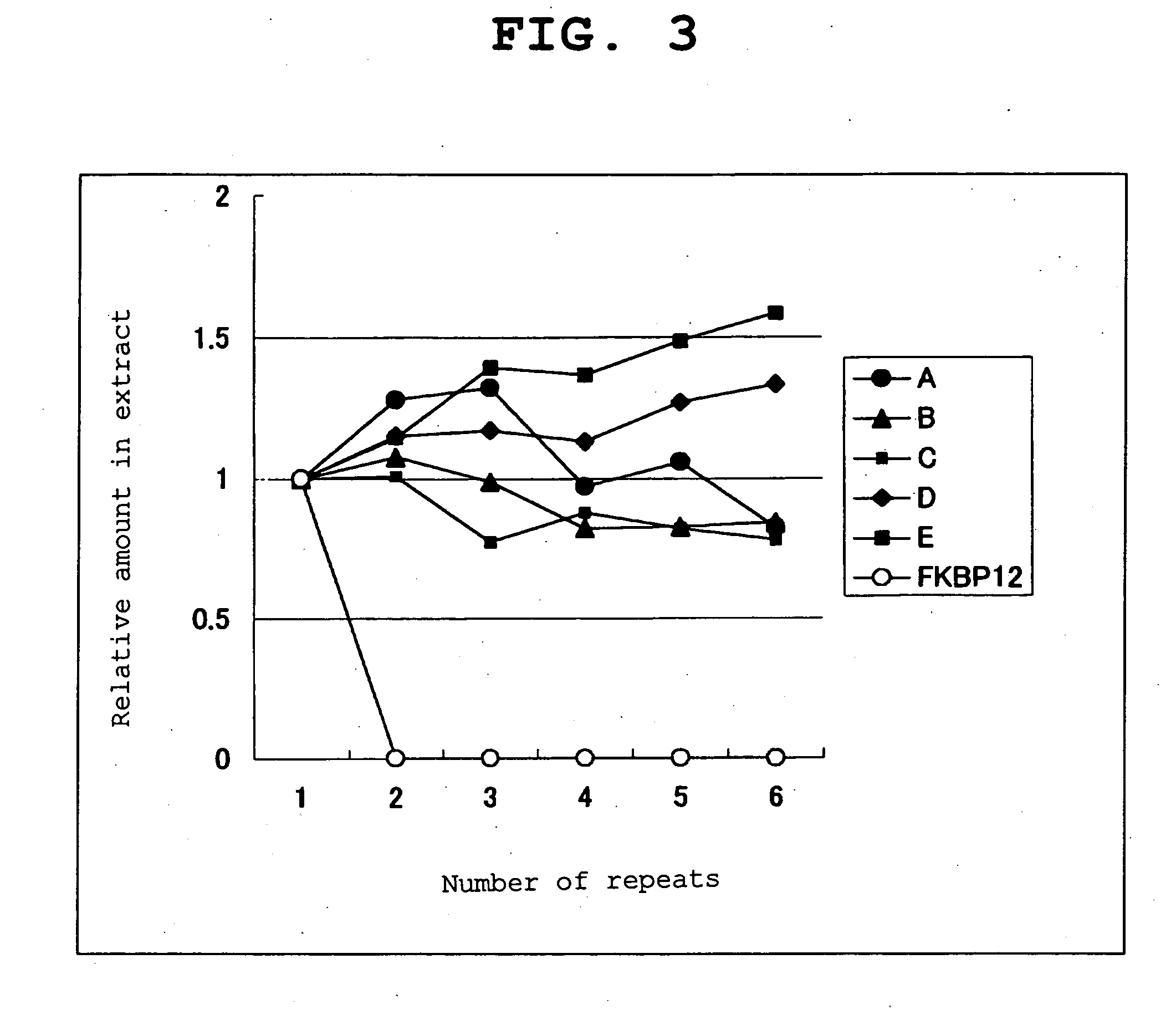Method of calibrating ligand specificity
a specificity and ligand technology, applied in chemical methods analysis, instruments, enzymology, etc., can solve the problems of inability to achieve sufficient ligand concentration, difficult to dissolve the required amount of ligand in the subject protein mixture, and substantially unperformable experiments
- Summary
- Abstract
- Description
- Claims
- Application Information
AI Technical Summary
Benefits of technology
Problems solved by technology
Method used
Image
Examples
production example 1
Synthesis of 17-allyl-14-(tert-butyl-dimethyl-silanyloxy)-1-hydroxy-12-{2-[4-(7-(tert-butyl-dimethyl-silanyloxy-carbonyl)heptanoyl-oxy)-3-methoxy-cyclohexyl]-1-methyl-vinyl)-23,25-dimethoxy-13,19,21,27-tetramethyl-11,28-diox-4-aza-tricyclo[22.3.1.04,9]octacos-18-ene-2,3,10,16-tetraone
[0075]
[0076] A mixture of 17-allyl-14-(tert-butyl-dimethyl-silanyloxy)-1-hydroxy-12-[2-(4-hydroxy-3-methoxy-cyclohexyl)-1-methyl-vinyl]-23,25-dimethoxy-13,19,21,27-tetramethyl-11,28-diox-4-aza-tricyclo[22.3.1.049]octacos-18-ene-2,3,10,16-tetraone (FK506; 138 mg, 0.15 mmol), O-mono(tert-butyl-dimethyl-silanyl)octanedioic acid (86.7 mg, 0.218 mmol), dimethylaminopyridine (DMAP; 16.5 mg, 0.098 mmol), 1-[3-(dimethylamino)propyl]-3-ethyl carbodiimide hydrochloride (EDC / HCl ; 69.1 mg, 0.261 mmol) and methylene chloride (CH2Cl2; 1 ml) was stirred at room temperature for 1.5 hours. The reaction product was poured over an ethyl acetate-water mixed liquid and extracted. The organic phase obtained was washed with...
production example 2
Synthesis of 17-allyl-1,14-di-hydroxy-12-(2-[4-(7-carboxy-heptanoyl-oxy)-3-methoxy-cyclohexyl]-1-methyl-vinyl }-23,25-dimethoxy-13,19,21,27-tetramethyl-11,28-dioxa-4-aza-tricyclo[22.3.1.04,9]octacos-18-ene-2,3,10,16-tetraone
[0078]
[0079] To a mixture of the 17-allyl-14-(tert-butyl-dimethyl-silanyloxy)-1-hydroxy-12-{2-[4-(7-(tert-butyl-dimethyl-silanyloxy-carbonyl)heptanoyl-oxy)-3-methoxy-cyclohexyl]-1-methyl-vinyl }-23,25-dimethoxy-13,19,21,27-tetramethyl-11,28-dioxa-4-aza-tricyclo[22.3.1.04,9]octacos-18-ene-2,3,10,16-tetraone prepared in Production Example 1 (44 mg, 0.037 mmol) and acetonitrile (0.88 ml), 46 to 48% aqueous hydrogen fluoride (HF) (0.12 ml) was gently added; this was followed by overnight stirring at room temperature. The reaction product was poured over an ethyl acetate-water mixed liquid and extracted. The organic phase obtained was washed with water and saline, after which it was dried with magnesium sulfate (MgSO4). After the MgSO4 was separated by filtration, co...
production example 3
Synthesis of FK506-bound TOYO-Pearl resin (TOYO-Pearl resin; TSKgel AF-amino)
[0082]
[0083] A mixture of the 17-allyl-1,14-di-hydroxy-12-{2-[4-(7-carboxy-heptanoyl-oxy)-3-methoxy-cyclohexyl]-1-methyl-vinyl }-23,25-dimethoxy-13,19,21,27-tetramethyl-11,28-dioxa-4-aza-tricyclo[22.3.1.04,9]octacos-18-ene-2,3,10,16-tetraone prepared in Production Example 2 (38.4 mg, 0.04 mmol), TOYO-Pearl resin (TSKgel AF-amino, 100 μl, free amino group (available amino group) content 0.01 mmol ; manufactured by Tosoh Corporation), EDC / HCl (9.2 mg, 0.048 mmol), 1-hydroxybenzotriazole (HOBt; 6.5 mg, 0.048 mmol) and dimethylformamide (DMF; 1 ml) was stirred at room temperature for 6 hours. The reaction end point was confirmed as the time when no residual amino groups became visually observable by the ninhydrin reaction. The reaction rate at this time was calculated to be about 24% (estimated ligand concentration=24 μmol / ml). After confirmation of completion of the reaction, the resin was washed with DMF fiv...
PUM
| Property | Measurement | Unit |
|---|---|---|
| temperature | aaaaa | aaaaa |
| LOGP | aaaaa | aaaaa |
| LOGP | aaaaa | aaaaa |
Abstract
Description
Claims
Application Information
 Login to view more
Login to view more - R&D Engineer
- R&D Manager
- IP Professional
- Industry Leading Data Capabilities
- Powerful AI technology
- Patent DNA Extraction
Browse by: Latest US Patents, China's latest patents, Technical Efficacy Thesaurus, Application Domain, Technology Topic.
© 2024 PatSnap. All rights reserved.Legal|Privacy policy|Modern Slavery Act Transparency Statement|Sitemap



